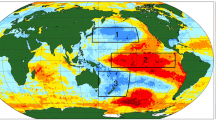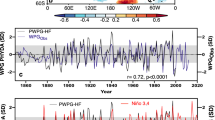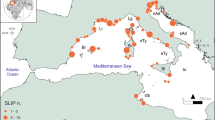Abstract
Quality controlled and recently homogenised mean sea level pressure records for the South Pacific are used to specify the location and variability of the South Pacific convergence zone (SPCZ) during the austral warm season (November–April). The SPCZ is the world’s largest rainfall band during the austral summer, when it dominates the climate of the South Pacific. A new index called the South Pacific convergence zone index (SPCZI) is derived, and is shown to be coherent with changes in low level wind convergence associated with the SPCZ. This index replaces the earlier SPCZ position index because it uses higher quality mean sea level pressure data than the superseded index and extends the time series further forward in time. The SPCZI allows interannual to decadal variability in the climate of the South Pacific to be tracked for more than a century from 1910/1911 to 2011/2012. During El Niño episodes the SPCZ is displaced by about 1°–3° east, and La Niña events 1°–3° west of the mean position on average. The index indicates a striking movement eastward for the period 1977/78–1998/99, compared with 1944/45–1976/77 in association with the Interdecadal Pacific oscillation (IPO). The eastward movement of the SPCZ in the late twentieth century is related to significant precipitation trends in the South Pacific region. Since 1998/99 the SPCZ has regressed westward with the negative phase change of the IPO. The long-term trend in the SPCZI is very small relative to the interannual to decadal variability and is not statistically significant, suggesting that there has been little overall change in the mean position of the SPCZ over the past century.










Similar content being viewed by others
References
Adler RF, Huffman GJ, Chang A, Ferraro R, Xie P, Janowiak J, Rudolf B, Schneider U, Curtis S, Bolvin D, Gruber A, Susskind J, Arkin P, Nelkin E (2003) The version 2 Global Precipitation Climatology Project (GPCP) monthly precipitation analysis (1979-present). J Hydrometeor 4:1147–1167
Australian Bureau of Meteorology and CSIRO (2011) Climate change in the Pacific: scientific assessment and new research. Volume 1: regional overview. Volume 2: country reports. Hennessy K, Power S and Cambers G (Scientific Editors)
Bergeron T (1930) Richtlinien einer dynamischen Klimatologie. Meteor Z 47:246–262
Brown JR, Power SB, Delage FP, Colman RA, Moise AF, Murphy BF (2011) Evaluation of the South Pacific convergence zone in IPCC AR4 climate model simulations of the twentieth century. J Clim 24:1565–1582
Cai W, Lengaigne M, Borlace S, Collins M, Cowan T, McPhaden MJ, Timmermann A, Power S, Brown J, Menkes C, Ngari A, Vincent EM, Widlansky MJ (2012) More extreme swings of the South Pacific convergence zone due to greenhouse warming. Nature 488:365–370. doi:10.1038/nature11358
Chung CTY, Power SB, Arblaster JM, Rashid HA, GL Roff (2013) Nonlinear rainfall response to El Niño and global warming in the Indo-Pacific. Clim Dyn. doi:10.1007/s00382-01301892-8
Collen B (1992) South Pacific historical climate network. Climate station histories. Part 1: Southwest Pacific region. New Zealand Meteorological Service, Wellington, p 113
Dee DP et al (2011) The ERA-interim reanalysis: configuration and performance of the data assimilation system. Q J R Meteorol Soc 137:553–597. doi:10.1002/qj.828/abstract
Folland CK, Salinger MJ, Rayner N (1997) A comparison of annual South Pacific island and ocean surface temperatures. Weather Clim 17:23–42
Folland CK, Renwick JA, Salinger MJ, Mullan AB (2002) Relative influences of the Interdecadal Pacific oscillation on the South Pacific convergence zone. Geophys Res Lett 29(13):21-1–21-4
Folland CK, Salinger MJ, Jiang N, Rayner N (2003) Trends and variations in South Pacific Island and ocean surface temperatures. J Clim 16(17):2859–2874
Griffiths GM, Salinger MJ, Leleu I (2003) Trends in extreme daily rainfall across the South Pacific and relationships to the SPCZ. Int J Climatol 23:847–869
Hubert LF, Krueger AF, Winston JS (1969) The double intertropical convergence zone—fact or fiction. J Atmos Sci 26:771–773
Huffman GJ, Adler RF, Bolvin DT, Gu G (2009) Improving the global precipitation record: GPCP version 2.1. Geophys Res Lett 36:L17808. doi:10.1029/2009GL040000
Hurrell JW, Vincent DG (1987) Significance of the South Pacific convergence zone (SPCZ) in the energy budget of the southern hemisphere tropics. Mon Weather Rev 115:1797–1801
Kiladis GN, Von Storch H, Van Loon H (1989) Origin of the South Pacific convergence zone. J Clim 2:1185–1195
Kornfield J, Hasler AF (1969) A photographic summary of the earth’s cloud cover for the year 1967. J App Met 8:687–700
Lorrey A, Dalu G, Renwick J, Diamond H, Gaetani M (2012) Reconstructing the South Pacific convergence zone position during the presatellite era: a La Niña case study. Mon Weather Rev 140:3653–3668. doi:10.1175/MWR-D-11-00228.1
Lough JM, Meehl GA, Salinger MJ (2011) Observed and projected changes in surface climate of the tropical Pacific, chapter 2. In: Bell JD, Johnson JE, Hobday AJ (eds) Vulnerability of tropical Pacific fisheries and aquaculture to climate change. Secretariat of the Pacific Community, Noumea, pp 49–99
Madden RA, Julian PR (1971) Description of a 40–50 day oscillation in the zonal wind in the tropical Pacific. J Atmos Sci 28:702–708
Matthews AJ (2012) A multiscale framework for the origin and variability of the South Pacific convergence zone. Quart J R Meteor Soc 138:1165–1178. doi:10.1002/qj.1870
Matthews AJ, Li HYY (2005) Modulation of station rainfall over the western Pacific by the Madden–Julian oscillation. Geophys Res Lett 32:L14827. doi:10.1029/2005GL023595
McGree S, Whan K, Jones D, Imielska A, Alexander L, Diamond H, Ene E, Finaulahi S, Inape K, Jacklick L, Kumar R, Laurent V, Malala H, Malsale P, Mitiepo R, Moniz T, Ngemaes M, Peltier A, Porteous A, Seuseu S, Skilling E, Tahani L, Teimitsi F, Toorua U, Vaiimene M (2013) An updated assessment of trends and variability in total and extreme rainfall in the Western Pacific. Int J Climatol. doi:10.1002/joc.3874
Meehl GA (1987) The annual cyclone and interannual variability in the tropical Pacific and Indian Ocean regions. Mon Weather Rev 115:27–50
Murphy BF, Power SB, McGree S (2013) The varied impacts of El Niño-Southern Oscillation on Pacific Island Countries. J Clim (submitted)
Power SB, Kociuba G (2011) The impact of global warming on the SOI. Clim Dyn 37:1745–1754. doi:10.1007/s00382-010-0951-7
Power SB, Smith IM (2007) Weakening of the walker circulation and apparent dominance of El Niño both reach record levels, but has ENSO really changed? Geophys Res Lett 34. doi:10.129/2007/GL30854
Power S, Folland C, Colman A, Mehta V (1999) Inter-decadal modulation of the impact of ENSO on Australia. Clim Dyn 15:319–324
Rhoades DA, Salinger MJ (1993) Adjustment of temperature and rainfall records for site changes. Int J Climatol 13:899–913
Salinger MJ (1995) Southwest Pacific temperatures: trends in maximum and minimum temperatures. J Atmos Res 37:87–100
Salinger MJ, Allan R, Bindoff N, Hannah J, Lavery B, Lin Z, Lindesay J, Nicholls N, Plummer N, Torok S (1996) Observed variability and change in climate and sea level in Australia, New Zealand and the South Pacific. In: Pearman GI, Manning M (eds) Greenhouse: coping with climate change. CSIRO Publishing, Melbourne, pp 100–126
Salinger MJ, Renwick JA, Mullan AB (2001) Interdecadal Pacific oscillation and South Pacific climate. Int J Climatol 21:1705–1721
Seward D, Rhoades DA (1986) A clustering technique for fission track dating of fully to partially annealed minerals and other non-unique populations. Nucl Tracks Radiat Meas 11:259–268
Solomon S, Qin D, Manning M, Chen Z, Marquis M, Averyt KB, Tignor M, Miller HL (eds) (2007) Contribution of working group I to the fourth assessment report of the intergovernmental panel on climate change. Cambridge University Press, Cambridge
Steiner JT (1980) The climate of the South West Pacific region: a review for pilots. N Z Met S Misc Pub No 166:36
Trenberth KE (1976) Spatial and temporal variations in the southern oscillation. Quart J R Meteor Soc 102:639–653
Trenberth KE (1991) Storm tracks in the Southern Hemisphere. J Atmos Sci 48(19):2159–2178
Trenberth KE, Shea DJ (1987) On the evolution of the Southern Oscillation. Mon Weather Rev 115:3078–3096
Troup AJ (1965) The southern oscillation. Quart J R Meteor Soc 91:490–506
Vincent DG (1994) The South Pacific convergence zone (SPCZ): a review. Mon Weather Rev 122:1949–1970
Vincent DG, North KH, Velasco RA, Ramsey PG (1994) Precipitation rates in the tropics based on the Q1-budget method: 1 June 1983-31 May 1987. J Clim 4:1949–1970
Vincent EM, Lengaigne M, Menkes CE, Jourdain NC, Marchesiello P, Madec G (2011) Interannual variability of the South Pacific convergence zone and implications for tropical cyclone genesis. Clim Dyn 36:1881–1896
Whan K, Alexander LV, Imielska A, McGree S, Jones D, Ene E, Finaulahi S, Inape K, Jacklick L, Kumar R, Laurent V, Malala H, Malsale P, Pulehetoa-Mitiepo R, Ngemaes M, Peltier A, Porteous A, Seuseu S, Skilling E, Tahani L, Toorua U, Vaiimene M (2013) Trends and variability of temperature extremes in the tropical Western Pacific. Int J Climatol. doi:10.1002/joc.3861
Widlansky M, Webster P, Hoyos C (2011) On the location and orientation of the South Pacific convergence zone. Clim Dyn 36:561–578. doi:10.1007/s00382-010-0871-6
Widlansky MJ, Timmermann A, Stein K, McGregor S, Schneider N, England MH, Lengaigne M, Cai W (2013) Changes in South Pacific rainfall bands in a warming climate. Nat Clim Change 3:417–423. doi:10.1038/nclimate1726
Xie S, Hume T, Jakob C, Klein S, McCoy R, Zhang M (2010) Observed large-scale structures and diabetic heating and drying profiles during TWP-ICE. J Clim 23:57–79. doi:10.1175/2009JCLI3071.1
Acknowledgments
This research was supported by the Pacific Australia Climate Change Science and Adaptation Planning (PACCSAP) Program, a program supported by AusAID, in collaboration with the Department of Industry, Innovation, Climate Change, Science, Research and Tertiary Education, and delivered by the Bureau of Meteorology and the Commonwealth Scientific and Industrial Research Organisation (CSIRO). We thank the Fiji Meteorological Service, the Samoa Meteorological Division, Howard Diamond (NOAA) and the Pago Pago National Weather Service for kindly providing data used in this study. We also thank Jo Brown and Brad Murphy for helpful comments on an earlier draft, Chris Folland for the revised draft and Christine Chung for producing Fig. 3.
Author information
Authors and Affiliations
Corresponding author
Appendix
Appendix
November–April South Pacific convergence zone index (SPCZI) using the normalised pressure difference (*10) between Apia and Suva, 1910/11–2011/12. The 1933–1992 period was used for standardization.
1911 | −11.4 | 1959 | 1.9 | 2007 | 1.4 |
1912 | 2.4 | 1960 | −4.6 | 2008 | −8.9 |
1913 | −3.6 | 1961 | −2.4 | 2009 | −4.7 |
1914 | 2.2 | 1962 | −8.3 | 2010 | 6.6 |
1915 | 15.1 | 1963 | −1.2 | 2011 | −0.7 |
1916 | −9.5 | 1964 | 0.7 | 2012 | −6.7 |
1917 | −5.8 | 1965 | −7.8 | ||
1918 | −2.2 | 1966 | 8.0 | ||
1919 | 11.9 | 1967 | −2.4 | ||
1920 | −0.5 | 1968 | 0.6 | ||
1921 | −8.7 | 1969 | 1.8 | ||
1922 | 1.1 | 1970 | 2.3 | ||
1923 | −5.4 | 1971 | −9.1 | ||
1924 | 1.6 | 1972 | −7.6 | ||
1925 | −6.0 | 1973 | 6.7 | ||
1926 | 22.2 | 1974 | −6.6 | ||
1927 | 7.5 | 1975 | −5.7 | ||
1928 | 2.5 | 1976 | −13.0 | ||
1929 | −2.5 | 1977 | −1.8 | ||
1930 | −2.7 | 1978 | 4.8 | ||
1931 | 8.1 | 1979 | 1.9 | ||
1932 | 2.1 | 1980 | 2.2 | ||
1933 | −3.5 | 1981 | 3.1 | ||
1934 | −0.9 | 1982 | −4.0 | ||
1935 | 2.0 | 1983 | 11.1 | ||
1936 | 4.2 | 1984 | −2.7 | ||
1937 | 1.6 | 1985 | 0.8 | ||
1938 | 7.2 | 1986 | 3.2 | ||
1939 | −7.0 | 1987 | 11.2 | ||
1940 | 15.3 | 1988 | −1.8 | ||
1941 | 17.9 | 1989 | −8.2 | ||
1942 | 13.6 | 1990 | 7.4 | ||
1943 | 1.7 | 1991 | −1.7 | ||
1944 | −3.9 | 1992 | 15.4 | ||
1945 | 4.0 | 1993 | 17.6 | ||
1946 | 0.8 | 1994 | 6.9 | ||
1947 | 2.4 | 1995 | 5.5 | ||
1948 | −6.5 | 1996 | 1.2 | ||
1949 | −7.6 | 1997 | 10.7 | ||
1950 | −9.5 | 1998 | 23.9 | ||
1951 | −9.9 | 1999 | 0.8 | ||
1952 | 3.2 | 2000 | 0.7 | ||
1953 | −4.1 | 2001 | 1.8 | ||
1954 | 0.8 | 2002 | −2.2 | ||
1955 | −5.4 | 2003 | −1.7 | ||
1956 | −9.2 | 2004 | 6.6 | ||
1957 | −9.7 | 2005 | 6.2 | ||
1958 | 7.3 | 2006 | 1.5 |
Rights and permissions
About this article
Cite this article
Salinger, M.J., McGree, S., Beucher, F. et al. A new index for variations in the position of the South Pacific convergence zone 1910/11–2011/2012. Clim Dyn 43, 881–892 (2014). https://doi.org/10.1007/s00382-013-2035-y
Received:
Accepted:
Published:
Issue Date:
DOI: https://doi.org/10.1007/s00382-013-2035-y




